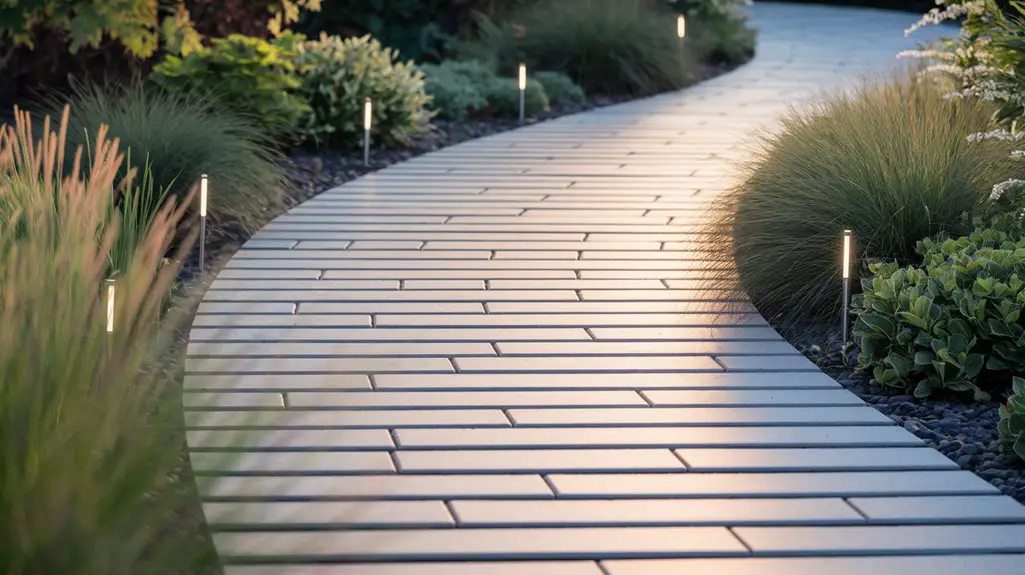You’re about to discover how flower-lined paths can transform your garden from ordinary to extraordinary. These vibrant walkways don’t just connect different areas—they become the highlight of your outdoor space. From dreamy lavender borders to dynamic wildflower meadow trails, the right flowering path adds color, texture, and life to your landscape. Let’s explore five distinctive designs that will inspire your next garden makeover.
Wildflower Meadow Pathways: Natural Beauty in Motion
While traditional garden paths offer structured elegance, wildflower meadow pathways invite a delightful spontaneity to your outdoor space.
You’ll create a living corridor that changes with the seasons, from spring’s first blooms to autumn’s final displays.
Choose native wildflower mixes suited to your climate for ideal growth and biodiversity. Incorporating native plants not only enhances the beauty of your garden but also provides essential habitats for local wildlife.
Mow a clear walking path through your mini-meadow, keeping edges softly blurred for a natural aesthetic.
Consider adding stepping stones for practical navigation during dewier mornings.
The beauty lies in the contrast—structured walkways amid seemingly untamed blossoms.
This approach not only delights the senses but supports local pollinators and requires minimal maintenance once established.
For small gardens, even narrow strips of wildflowers alongside a simple gravel path create this enchanting meadow effect.
Lavender-Lined Walkways for Fragrant Garden Journeys

Few garden elements create such sensory impact as lavender-lined pathways, where every step releases aromatic oils into the air around you.
These fragrant borders transform ordinary walkways into multisensory experiences that engage both sight and smell.
For maximum effect, plant compact varieties like ‘Hidcote’ or ‘Munstead’ that won’t sprawl excessively into walking areas.
Space plants 12-18 inches apart in well-draining soil where they’ll receive at least 6 hours of sun daily.
The silvery-green foliage creates striking contrast against gravel, brick, or flagstone surfaces.
You’ll enjoy peak blooms in early summer, but lavender’s structure provides year-round interest. Additionally, incorporating colorful flower varieties alongside lavender can enhance the visual appeal of your pathway.
For continuous fragrance, try brushing your hands across the plants as you pass—this simple gesture releases their calming essential oils.
Rainbow Border Paths: Creating Colorful Garden Transitions

Rainbow border paths transform garden walkways into living art galleries where color becomes the guiding principle. Design these changes by arranging flowers in rainbow sequence—reds nearest your starting point, moving through orange, yellow, blue, and violet as you progress.
Select varieties with staggered bloom times to maintain continuous color throughout growing seasons. Low-growing options like pansies, sweet alyssum, and creeping phlox work beautifully alongside taller accents such as salvia, cosmos, and delphinium. Incorporating colorful flower varieties can enhance the visual appeal and biodiversity of your garden.
For maximum impact, consider how light plays across your path during different times of day. Morning sun illuminates eastern-facing blooms, while sunset casts magical hues on western exposures.
You’ll want to integrate stepping stones or pavers that complement your color scheme—gray slate provides a neutral canvas that won’t compete with your floral rainbow display.
Butterfly and Bee-Friendly Flowering Path Designs
Designing a garden path that attracts pollinators isn’t just environmentally responsible—it’s aesthetically rewarding. Select native flowering plants with varied bloom times to guarantee continuous nectar sources throughout growing seasons.
Position your pollinator-friendly path in a sunny location, as most beneficial insects prefer warmth and direct light.
- Choose flat-faced flowers like echinacea, black-eyed Susans, and zinnias that provide easy landing pads for butterflies and bees.
- Incorporate herbs such as lavender, thyme, and oregano along path edges for both culinary use and pollinator attraction.
- Add shallow water features or puddling stations near your path where butterflies can gather minerals and hydrate.
Consider creating clusters of the same flower variety rather than scattered individual plants—this concentrated approach makes your path more visible to passing pollinators. Additionally, including native flowering plants in your design will enhance the habitat’s sustainability and support local ecosystems.
Seasonal Bloom Rotation: Year-Round Colorful Pathways
Creating a year-round colorful pathway requires thoughtful planning and strategic plant selection so your garden remains visually engaging across all seasons.
Begin with spring bulbs like tulips and daffodils, shifting to summer perennials such as lavender, salvia, and coneflowers. As temperatures cool, incorporate autumn bloomers like chrysanthemums, asters, and ornamental grasses for texture and movement.
Don’t neglect winter interest—plant hellebores, winter jasmine, and evergreen ground covers that maintain structure during dormant months. Including seasonal vegetables can also enhance the utility and aesthetic of your garden path.
Group plants with complementary bloom times, ensuring that as one variety fades, another emerges. Consider foliage color and texture as important design elements when flowers aren’t present.
For effortless changes, incorporate self-seeding annuals like cosmos and nigella that naturally fill gaps between seasonal stars.
Conclusion
Your garden paths don’t need to be plain hardscaping—they can become vibrant statements that define your outdoor space. With these five flower-focused designs, you’ll transform mundane walkways into sensory experiences that evolve throughout the seasons. Why settle for ordinary when your pathways can burst with color, fragrance, and life? Choose designs that reflect your personality while creating harmonious connections between different garden zones.



